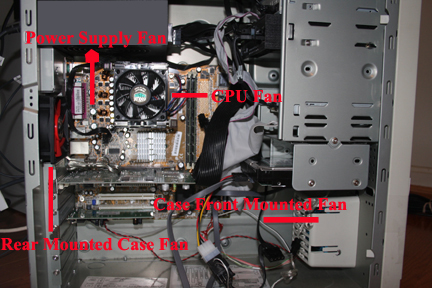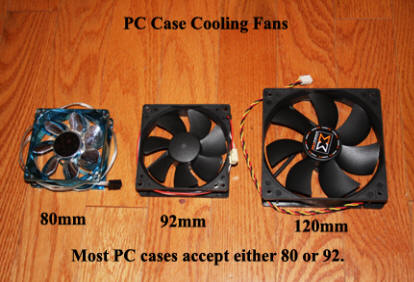
"PC - BYO & DIY Cooling Tips"
"PC - General Improved Cooling Tips"
Ron Stultz
7 April 2009
Summary: at a minimum, monitor internal personal computer temperatures, keep fans clean and add a case fan if possible
The actions you can take to improve PC cooling range from easy and obvious to those that border on "black magic." The following are the easy and obvious actions:
Monitor PC temperatures. Most motherboards and hard drives have thermal sensors built into them but most systems do not provide a method of monitoring these temperatures. A very nice free program, which seems to work with most motherboards is SpeedFan. Download this program and check the temperatures in your PC.
PC location. Make sure PC is in a location that does not block air flow around it. Give your PC 6 inches of breathing room on all sides. Make sure exhaust ports like on the power supply and any rear case fan(s) have plenty of room to exhaust heat away. If the rear of the PC is sit right up next to a wall, case heat exhausting is hampered. Finally, do not block the front of the PC with anything. Most PC's have holes in the front, in behind the plastic cosmetic cover, that allow room ambient air to be pulled in.
PC case orientation. Most PC cases are designed to be sit only one way. If you place a mid tower on its side, you may be blocking some of the few air vents it has.
PC side panels. If your PC is running hot, you may be tempted to just remove one or both of the PC's case side panels. This will open the PC to ambient room air and reduce case internal temperatures but this is dangerous. No matter the design of your PC there are rotating fans in there and electrical voltages that could harm pets, children and you. And, don't you find it amazing that if something will fall or otherwise be shoved into something you do not want it in, it absolutely will sooner or later? If you are going to remove a PC case side panel, make sure the open side is not accessible for foreign objects like fingers or pens or.....
Fans Turning? Ever PC has at least one fan and usually 2 or 3 to move air into, around and out of the case, but fans fail. Some PC motherboards monitor fan reported revolutions per minute (RPM) and signal you when a fan has stopped turning while other systems do not. So periodically, you need to visually inspect your system and confirm all fans are turning. To do this, power on your PC and let it run for 20 - 30 minutes for it to come up to some semi-stable temperature. Then power off your PC and on most PC's anyway, remove the left side case panel as you face the front of the PC. Now power up your PC and with a flashlight and room for you to see up inside make sure: (1) the fan on the CPU chip (fan mounted on a metal block of some kind) right on the motherboard is turning; (2) the fan(s) inside the power supply, if it has one or more are turning. The power supply fan can be mounted underneath the power supply right above the processor fan or in the end of the power supply inside the PC or on the end mounted to the case. Some power supplies even have 2 fans, one at either end while a cheap, low wattage power supply may not have any fan at all. (3) Check that any case mounted fans are turning. Of all fans inside a PC, the one that must be turning all the time is the fan mounted to the heat sink on the CPU chip. If this fan is not turning, shut down your PC and either replace the cpu fan yourself or have the system repaired before you use the system again. CPU's do have built in heat protection such that they will shut down the system if the chip becomes too hot but heat can absolutely kill a processor chip and then you have a semi-major problem. Some power supplies temperature control its internal fan(s) meaning the fans do not turn unless needed. If you had your system powered on for 20 to 30 minutes, the fans in the power supply should be turning or at least one should. If the fans inside a power supply are not turning, you will either have to remove the power supply from the PC and replace the defective fan(s) inside the supply or replace the entire power supply. Most case fans are not thermally controlled, meaning they should be turning no matter the case's internal temperature. If a case fan has failed, you will have to replace it but before you buy a replacement determine the size of the fan you.


Fans free of dust. The inside of a PC case can become incredibly dirty. I know it appears as a sealed box, but room air is or should be passing through the PC case all the time and carrying with it dust. With you PC open for inspection, make sure the interior is clean. Dirt and dust significantly reduce a component or device's ability to shed heat. With the PC powered off and unplugged from the wall outlet or clip strip, remove dirt with a vacuum or with a cloth. Using a can of compressed air, which is available at Staples and other retailers, while your vacuum is running, blow compressed air into the fan on top of the CPC heat sink and if possible through the cooling fins of the CPU heat sink. Try to capture as must dust as possible with the vacuum as it is no sense putting dust back into the room where it will simply be sucked into the PC again. Then blow air through the power supply such that dust is blown out the back of the PC.
Cables. Inside any PC there are multiple cables to include: lots of cables coming out of the power supply; hard drive interface cables; possibly a floppy drive cable and one or more CD\DVD interface cables. Here, you want to make sure cables are not impeding air flow in or out of the unit. Also you want to make sure cables are not tightly up against memory, which can easily happen because of memory's location on the motherboard and power supply cable routing. Before you separate or reroute any cables, power down the PC and unplug from the wall outlet or clip strip. If you do move cables around or separate them where they are in a tight bundle, make sure all cable connections to the motherboard, hard drives, floppy drive and any CD/DVD ROM drives are tightly in place before repowering the system.
Thermal paste. Of all temperatures inside a PC, the most important one is how hot the CPU chip becomes when stressed. CPU chip temperatures can range from around 100 degrees Fahrenheit when the processor is "idling" to 155 degrees. Any CPU temperature above 122 degrees is considered dangerous. To keep the CPU chip cool, a heat skin and fan are installed right on the chip but unfortunately most systems are shipped with no thermal conductive paste between the top of the chip and the bottom of the heat sink, thus not providing as conducive a thermal transfer as possible. To help this situation, you can buy thermal conductive paste at Radio Shack and other retailers, remove the CPU heat sink and attached fan and apply paste to the top of a cool CPU chip and remount the heat sink and fan. How the CPU chip heat sink is mounted to the motherboard varies by the type of CPU chip socket you have but in general, the heat sink and fan have clips that are pushed down over small tabs or into small holes in a frame around the CPU chip. Although not difficult, you must be very careful removing the CPU heat sink and fan as a slip of a screwdriver can easily damage a motherboard component for which there is no easy repair other than complete motherboard replacement. Finally, before applying thermal paste to the top of the CPU chip, make sure it is not hot and clean. Also make sure the bottom of the heat sink is clean and void of any paint. Some heat sinks have a cooper insert where the heat sink mates to the CPU chip. And believe it or not, some heat sinks are designed to go on the chip socket in a certain way so pay attention when you remove.
Upgrade the processor fan. The CPU heat sink and fan installed in most off-the-shelf systems is very basic with enough cooling surface and cubic feet per minute (CFM) to handle most computing requirements of the average user but higher performance processor fans are available. I personally have never upgraded the fan on the processor as the fan is only be as good as the air coming into and exhausting the system. I mean by this, that just replacing the processor fan with some super copper or other high performance fan may help reduce processor temperature but probably will do nothing to cool memory or other areas of the motherboard. High performance processor fans cost between $40 and $80. If you do want to upgrade your processor fan, make sure it get a fan that will mount to the type of processor socket assembly you have in your PC. Also check that there is room inside the PC for the new fan. In most systems, the advanced graphics processor (AGP) card is very close to the processor chip and you could face a form factor problem getting a new, super size processor heat skin and fan in place.
Upgrade case fans. When most folks have PC cooling problems, they immediately either add fans or replace what fans they have with higher CFM units. The case fans in most all off-the-shelf desktop and mid-tower systems are very basic, limited RPM, low CFM units but are relatively quiet. Replacement fans are available from low to tremendously high CFM outputs. Keep in mind that in general, the higher the CPU fan, the more noise it will generate. You can buy a $4 fan with XX CFM output or a $20 fan with the same output but the more expensive will have a reduced noise level. Certainly, if one or more of the fans in your system is dead, replace it but do not automatically add a fan just because you have a problem and can easily add a fan. It has been my experience that simply adding a fan to a system does not solve its thermal problems or rather adding a fan in the wrong location does not solve a thermal problem. Finally, there are case fans available that have extremely high CFM and when properly placed inside a PC case, can significantly help with cooling but these fans are so loud as to be simply unbearable for very long. If you have a severe thermal problem and nothing else in this "shared knowledge" seems to help, try one of the super duper fans but plug your ears.